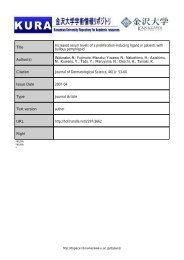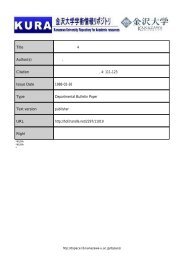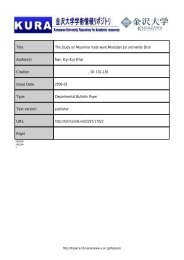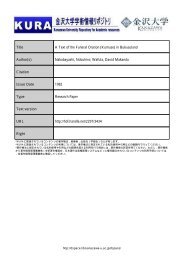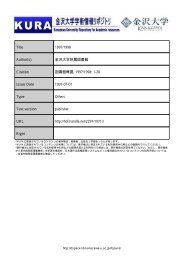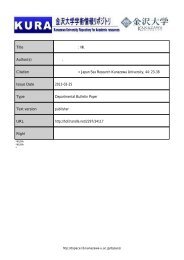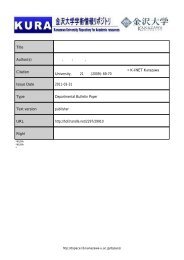Petrology of the Yugu peridotites in the Gyeonggi Massif, South Korea
Petrology of the Yugu peridotites in the Gyeonggi Massif, South Korea
Petrology of the Yugu peridotites in the Gyeonggi Massif, South Korea
You also want an ePaper? Increase the reach of your titles
YUMPU automatically turns print PDFs into web optimized ePapers that Google loves.
is possibly ascribed to its small dimension and/or<br />
rapid uplift for effective cool<strong>in</strong>g <strong>of</strong> <strong>the</strong> mantle slice.<br />
Before <strong>the</strong> rapid uplift, <strong>the</strong> <strong>peridotites</strong> should have<br />
been cooled and hydrated with<strong>in</strong> <strong>the</strong> sp<strong>in</strong>el lherzolite<br />
stability field because <strong>of</strong> <strong>the</strong> change <strong>of</strong> amphiboles<br />
from hornblende to tremolite without<br />
production <strong>of</strong> plagioclase (Fig. 8). The estimated<br />
P–T trajectory <strong>of</strong> <strong>the</strong> <strong>Yugu</strong> <strong>peridotites</strong> (Fig. 8) is<br />
similar to that <strong>of</strong> <strong>the</strong> Bibong <strong>peridotites</strong>, but is<br />
different from that <strong>of</strong> <strong>the</strong> Baekdong <strong>peridotites</strong><br />
(Fig. 4 <strong>of</strong> Seo et al. 2005). The P–T path <strong>of</strong> retrogressive<br />
metamorphism <strong>of</strong> metamorphic rocks<br />
associated with <strong>the</strong> <strong>peridotites</strong> <strong>in</strong> <strong>the</strong> Hongseong<br />
area (Kim et al. 2006) meets <strong>the</strong> peridotite path<br />
under low-P, low-T conditions (Fig. 8).<br />
The age <strong>of</strong> emplacement <strong>of</strong> <strong>the</strong> <strong>Yugu</strong> <strong>peridotites</strong><br />
is unfortunately unknown. The preservation <strong>of</strong><br />
primary mantle m<strong>in</strong>erals <strong>in</strong> <strong>the</strong> central part <strong>of</strong> <strong>the</strong><br />
body may exclude <strong>the</strong> possibility that <strong>the</strong> <strong>peridotites</strong><br />
had suffered from <strong>the</strong> regional metamorphism<br />
synchronous with <strong>the</strong> surround<strong>in</strong>g Precambrian<br />
gneiss. It is well known that <strong>the</strong> solid <strong>in</strong>trusive<br />
mantle <strong>peridotites</strong> <strong>of</strong> Precambrian age have been<br />
<strong>in</strong>tensely altered. For example, <strong>peridotites</strong> <strong>of</strong> <strong>the</strong><br />
mantle section <strong>of</strong> Proterozoic ophiolites have been<br />
severely altered; <strong>the</strong>ir oliv<strong>in</strong>es and pyroxenes have<br />
been completely altered to serpent<strong>in</strong>es or carbonates<br />
(Quick 1990; Gahlan et al. 2006). The small<br />
bodies <strong>of</strong> peridotite and serpent<strong>in</strong>ite <strong>in</strong>clud<strong>in</strong>g <strong>the</strong><br />
<strong>Yugu</strong> peridotite body are distributed only near <strong>the</strong><br />
boundary with <strong>the</strong> Okcheon Belt (Wee et al. 1994).<br />
The similarity between <strong>the</strong> strike <strong>of</strong> strong foliation<br />
<strong>of</strong> <strong>the</strong> <strong>Yugu</strong> <strong>peridotites</strong>, N30 to 70°E, and <strong>the</strong><br />
direction <strong>of</strong> <strong>the</strong> Jurassic to Cretaceous s<strong>in</strong>istral<br />
fault system (Xu et al. 1989; Lee 1999) may be <strong>in</strong><br />
favor <strong>of</strong> <strong>in</strong>trusion <strong>of</strong> <strong>the</strong> <strong>Yugu</strong> <strong>peridotites</strong> prior to<br />
or synchronous with <strong>the</strong> fault formation. Kim et al.<br />
(2006) obta<strong>in</strong>ed a Triassic age (ca 231 Ma) by<br />
SHRIMP zircon dat<strong>in</strong>g from retrogressed eclogite<br />
associated with <strong>the</strong> Bibong peridotite. Mafic<br />
garnet granulites associated with <strong>the</strong> Baekdong<br />
<strong>peridotites</strong> show Sm–Nd isochron ages <strong>of</strong> 268–<br />
297 Ma (Oh et al. 2004). These possibly <strong>in</strong>dicate <strong>the</strong><br />
emplacement <strong>of</strong> <strong>the</strong> Hongseong peridotite bodies<br />
<strong>in</strong> <strong>the</strong> late Paleozoic to early Mesozoic but before<br />
<strong>in</strong>itiation <strong>of</strong> <strong>the</strong> s<strong>in</strong>istral fault system.<br />
Peridotite bodies (Yang et al. 1993) are also associated<br />
with ultrahigh-pressure metamorphic rocks<br />
<strong>in</strong> <strong>the</strong> Dabie–Sulu Collision Belt, Ch<strong>in</strong>a, which is<br />
considered to be <strong>the</strong> westward extension <strong>of</strong> <strong>the</strong><br />
southwestern part <strong>of</strong> <strong>the</strong> <strong>Gyeonggi</strong> <strong>Massif</strong> by<br />
Oh and co-workers (Oh 2006; Oh et al. 2005; Oh<br />
& Kusky 2007). The Sulu <strong>peridotites</strong>, however,<br />
exhibit characteristics <strong>of</strong> higher-pressure<br />
equilibration than <strong>the</strong> <strong>Gyeonggi</strong> <strong>peridotites</strong> <strong>of</strong><br />
<strong>Korea</strong>. Garnet-bear<strong>in</strong>g lherzolites and harzburgites<br />
are predom<strong>in</strong>ant <strong>in</strong> <strong>the</strong> Sulu Belt (Yang et al.<br />
1993; Zhang et al. 1994; Yoshida et al. 2004).<br />
Primary chromian sp<strong>in</strong>els are preserved only <strong>in</strong><br />
harzburgites with or without garnets (Zhang et al.<br />
1994; Yoshida et al. 2004). It is noteworthy that <strong>the</strong><br />
most depleted harzburgite protolith from <strong>the</strong> Sulu<br />
Belt, composed <strong>of</strong> oliv<strong>in</strong>e with Fo91–92 and sp<strong>in</strong>el<br />
with Cr# = 0.4 to 0.5 (Yoshida et al. 2004), is<br />
similar to <strong>the</strong> most depleted harzburgite from <strong>the</strong><br />
<strong>Gyeonggi</strong> <strong>Massif</strong>, <strong>Korea</strong> (Fig. 4). The compositional<br />
range <strong>of</strong> oliv<strong>in</strong>e, Fo90 <strong>in</strong> lherzolites to Fo92 <strong>in</strong><br />
harzburgites (Yang et al. 1993; Yoshida et al. 2004),<br />
is almost <strong>the</strong> same as that <strong>in</strong> <strong>the</strong> sp<strong>in</strong>el lherzolites<br />
to harzburgites <strong>of</strong> <strong>the</strong> <strong>Gyeonggi</strong> <strong>Massif</strong> (Fig. 4).<br />
The <strong>peridotites</strong> from Bibong and Baekdong, which<br />
display flat and U-shaped REE patterns (Seo et al.<br />
2005), are similar to some Dabie–Sulu garnet <strong>peridotites</strong><br />
<strong>of</strong> Type A, which are <strong>in</strong>terpreted to be<br />
derived from <strong>the</strong> mantle wedge (Zhang et al. 2000).<br />
In summary, <strong>the</strong> sp<strong>in</strong>el <strong>peridotites</strong> from <strong>the</strong> <strong>Gyeonggi</strong><br />
<strong>Massif</strong>, <strong>South</strong> <strong>Korea</strong> are representative <strong>of</strong> <strong>the</strong><br />
upper mantle shallower than <strong>the</strong> <strong>peridotites</strong> with<br />
or without garnets from <strong>the</strong> Dabie–Sulu Belt,<br />
be<strong>in</strong>g <strong>in</strong> accordance with <strong>the</strong> difference <strong>of</strong> P–T<br />
paths <strong>of</strong> associated metamorphic rocks (fig. 5 <strong>of</strong> Oh<br />
et al. 2004). The two peridotite suites, however,<br />
show similarities <strong>in</strong> REE distribution pattern and<br />
partial melt<strong>in</strong>g degree.<br />
As discussed by Arai et al. (2001) <strong>the</strong> arc-type<br />
mantle <strong>peridotites</strong> have been rarely documented<br />
as xenoliths from <strong>the</strong> Asian cont<strong>in</strong>ental marg<strong>in</strong>.<br />
The arc-type <strong>peridotites</strong> are, however, expected to<br />
exist <strong>in</strong> <strong>the</strong> upper mantle beneath <strong>the</strong> cont<strong>in</strong>ental<br />
marg<strong>in</strong> because accretion <strong>of</strong> arcs to <strong>the</strong> cont<strong>in</strong>ental<br />
marg<strong>in</strong> is one <strong>of</strong> <strong>the</strong> fundamental processes for<br />
cont<strong>in</strong>ent growth (e.g. Taylor & McLennan 1985).<br />
As suggested by Arai et al. (2001), <strong>the</strong> sub-arc<br />
<strong>peridotites</strong> or oceanic (ophiolitic) <strong>peridotites</strong> have<br />
been preserved <strong>in</strong> <strong>the</strong> cont<strong>in</strong>ental marg<strong>in</strong>, where<br />
accretionry processes are prom<strong>in</strong>ent, only when<br />
<strong>the</strong>y have been emplaced on or with<strong>in</strong> <strong>the</strong> crust.<br />
O<strong>the</strong>rwise, <strong>the</strong>y have been possibly replaced or<br />
tectonically eroded by cont<strong>in</strong>ental type <strong>peridotites</strong><br />
uprisen diapirically (Arai et al. 2001).<br />
SUMMARY AND CONCLUSIONS<br />
Peridotites from <strong>Yugu</strong>, <strong>Korea</strong> 497<br />
1. The <strong>Yugu</strong> peridotite body and some o<strong>the</strong>r small<br />
bodies show a NNE-trend<strong>in</strong>g distribution near<br />
<strong>the</strong> boundary with <strong>the</strong> Okcheon Belt with<strong>in</strong> <strong>the</strong><br />
southwestern <strong>Gyeonggi</strong> <strong>Massif</strong>, <strong>Korea</strong>. The<br />
© 2008 The Authors<br />
Journal compilation © 2008 Blackwell Publish<strong>in</strong>g Asia Pty Ltd




